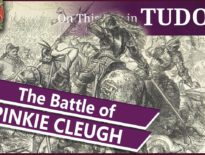On this day in Tudor history, 12th September 1573, Protestant reformer, and leading politician in the reign of Mary, Queen of Scots, Archibald Campbell, 5th Earl of Argyll, died suddenly at Barbreck. He had got married six weeks earlier and had shown no signs of illness before retiring to bed.
Argyll was the third most important noble in Scotland, the most important highland chief, and a founder of the Lords of the Congregation. He went from opposing Mary, Queen of Scots, to leading her troops in battle.
Why?
Find out all about this interesting Scot's life and career in today's talk.
Also on this day in Tudor history, 12th September 1555, in the reign of Catholic Queen Mary, the trial of Thomas Cranmer, Archbishop of Canterbury, began in Oxford. Find out what happened at his trial, and what happened next, in last year’s video:
Also on this day in history:
- 1542 – Death of Sir Edmund Knightley, lawyer and Sergeant-at-Law. He was buried at Letheringham in Suffolk.
- 1544 – Baptism of Richard Bancroft, Archbishop of Canterbury in the reign of James I, at Prescot, near Farnworth, in Lancashire.
- 1559 – Death of Marten Micron (Martin Micronius), Dutch theologian and Protestant minister in the strangers' churches of London, from the plague at Norden in Lower Saxony, Germany.
Transcript:
On this day in Tudor history, 12th September 1573, Protestant reformer, and leading politician in the reign of Mary, Queen of Scots, Archibald Campbell, 5th Earl of Argyll, died suddenly at Barbreck. He had got married six weeks earlier and had shown no signs of illness before retiring to bed. He was laid to rest in the family mausoleum at Kilmun Church on the Holy Loch.
Argyll was the third most important noble in Scotland, holding the offices of justice-general, master of the royal household and chancellor. He was also the most important highland chief and an important landowner too, holding land in the west highlands and Scottish islands. His biographer, Jane E. A. Dawson, notes that he was “the most powerful magnate in the British Isles”.
Let me give you some more facts about this important Scot…
• Archibald Campbell, 5th Earl of Argyll, was born in around 1538 and was the eldest son of Archibald Campbell, 4th Earl of Argyll, and his first wife, Lady Helen Hamilton, daughter of James Hamilton, 2nd Earl of Arran and a man who was regent of Scotland for Mary, Queen of Scots.
• In his childhood, Archibald was fostered by Colin Campbell of Ardkinglas and his wife, Matilda. He was known as Lord Lorne in his youth, the courtesy title given to the heir of the Earl of Argyll.
• In 1554, he married Lady Jean Stewart, illegitimate daughter of King James V by Elizabeth Beaton, making him brother-in-law of Mary, Queen of Scots. Jean had been brought up in the household of Marie de Guise, James V’s wife. The marriage brought him into the queen’s close royal circle.
Archibald and Jean’s marriage was childless and unhappy. The couple separated in 1567 and divorced in June 1573. Archibald did have a number of illegitimate children though.
• In 1555, he led a military expedition to Ireland.
• His father had been converted to Protestantism and employed reformers in his household, such as John Carswell, who, in turn, influenced Archibald. Archibald later acted as a patron of Carswell, who translated the liturgy of the Protestant kirk, the Book of Common Order, into Gaelic.
Archibald was also influenced by hearing John Knox preach in the winter of 1555/6. As a result, he and his father went on to give their support to ecclesiastical reform. When his father was dying, he told Archibald “to study to set forward the public and true preaching of the Evangel of Jesus Christ and to suppress all superstition and idolatry”.
• He father died in November 1558 and Archibald became Earl of Argyll.
• Argyll was a founding member of the Lords of the Congregation, a group of Scottish lords who favoured reformation of the church according to Protestant principles and also an alliance with England. The Lords of the Congregation rose against Marie de Guise with Argyll providing the majority of soldiers for the cause. In July 1559 they took Edinburgh, although the castle held out against them. They then withdrew under the Articles of Leith. Argyll and Lord James Stewart, later Earl of Moray, negotiated the Treaty of Berwick in 1560 with William Cecil, Elizabeth I’s chief advisor, to secure English help against Marie de Guise, in exchange for Argyll helping the English with Ulster in Ireland.
• Marie died in June 1560. On her deathbed, she reconciled with the Lords of the Congregation, leading to the Treaty of Edinburgh between England and Scotland. This allowed Argyll, Lord James and William Maitland of Lethington to steer Parliament into passing acts against papal authority and Catholic worship in Scotland, and establishing a new Protestant kirk.
• Mary, Queen of Scots returned to Scotland in 1561 following the death of her husband, King Francis II of France, and she chose Argyll, Lord James and Maitland as her chief advisors, although she continued celebrating mass privately.
• Argyll and Moray opposed the marriage of Mary and Lord Darnley, and the Protestant lords rose in rebellion against their queen. They failed and all but Argyll, who had substantial lands to retreat to, were forced into exile. He felt betrayed by England’s lack of support at that time and so stopped helping Elizabeth I in Ireland, causing problems for her with Ulster.
• He was able to climb back in favour with Mary in 1566 and was named as one of the regency council for her son, the future James VI, in case Mary died while giving birth to him.
• He was present when the queen visited her husband, Lord Darnley, on the night before his murder in February 1567, and also presided over the Earl of Bothwell’s trial for the murder, in which Bothwell was acquitted.
• He was, however, not happy with Mary’s marriage to Bothwell and joined those lords who rebelled against her and fought her and Bothwell at Carberry Hill, where Mary was captured and imprisoned. He didn’t go as far as supporting her subsequent forced abdication, though, and so left the Lords of the Confederate.
• When Mary escaped from Lochleven Castle he led her troops as lieutenant-general at the Battle of Langside in May 1568 but Mary’s forces were defeated. It is unclear whether Argyll was taken ill at the beginning of the battle or whether that was just a rumour. Mary fled the battlefield and eventually fled into England, where she was imprisoned. Argyll eventually reconciled with the Earl of Lennox, who was acting as regent for Mary’s son, King James VI, and persuaded others who had supported Mary to reconcile and support the new king. He worked closely with James Douglas, 4th Earl of Morton, who was regent from 1572, and was made lord chancellor in January 1573.
• At the beginning of August 1573, Argyll married Jean or Janet Cunningham, daughter of the Earl of Glencairn. Sadly, Argyll died suddenly at Barbreck, while travelling through Argyll, on 12th September 1573. He’d been perfectly fine when he’d gone to bed the night before, but was found dead that morning. His cause of death was given as the “stone”, which was used for internal disorders. His half-brother, Colin, succeeded him as Earl of Argyll.
• Argyll’s wife was pregnant at the time of his death and gave birth to a stillborn son in June 1574.
• Argyll was buried at Kilmun Parish Church, the traditional burial place of Clan Campbell.



Heart attack due to over exertion? Sad though for his pregnant widow, unless she slipped him something.